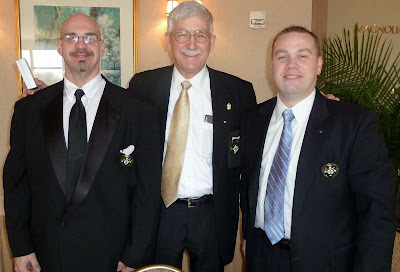(Many of the photos I shot at Masonic Week are blurry or otherwise unusable. Wanting to travel light, I brought my Panasonic Lumix – a perfectly serviceable camera – instead of the Nikon, which was a mistake for this kind of interior photography. Lesson learned. Won’t happen again.)
It was love at first sight, when I happened upon the Grand College of Rites while surfing the web for odd Rose Croix rituals one day about nine years ago. It seemed to me to be the perfect Masonic fraternity: one overall purpose expressed in one quality publication introduced at its one meeting per year. And I have looked forward to, and have enjoyed those single meetings yearly, and always look forward to Collectanea, the book produced by Arturo de Hoyos and the GCR’s Publications Committee.
The College hosted its 80th Annual Convocation Saturday morning in Alexandria, Virginia during Masonic Week, for the changing of the guard, the unveiling of the new Collectanea, and other necessary business, etc.
 |
| M.I. Franklin Boner invests our new Grand Chancellor, M.I. Martin Starr, with the jewel of office. |
Aaron could not be with us this year, and yet he was with us because his labors for the College are vital.
In other headlines, three Fellows of the College were tapped to receive the Knight Grand Cross: Matthew Gibbon and Scott Schlappi, who staff the registration desk outside the meeting, and M.I. Starr, upon his installation as Grand Chancellor.
The College now has 1,222 members (excluding new members who just joined at the meeting).
Other notable deaths in the past year include two Past Grand Chancellors: William H. Thornley, Jr. (1998) and Frederick H. Lorenson (2003).
But about the new Collectanea: This, the 2010 publication, contains the Craft degrees of the Rite of Strict Observance, plus two high degree rituals from the 18th century. In introducing the text, Grand Archivist Art de Hoyos explained it is similar to that he’d published a few years ago in Heredom, but with some ambiguities and inaccuracies stemming from their translations corrected. Strict Observance, he added, was the rite promoted by Baron von Hund, and it is the ancestor of CBCS and the Swedish Rite. The two high degrees are translations of original French into German and into English here. They have Rosicrucian similarities, said de Hoyos, and these rituals were saved from confiscation by the Nazis during their destruction of Masonic lodges.
These Craft degrees are fascinating for their differences from the Anglo-American work we know so well. Unless I misunderstand, there is a break from Newtonian thought.
Said to the Apprentice:
“There is nothing here that does not present the opportunity for much contemplation. Apply yourself to it. To investigate mysteries is not forbidden to a noble student of wisdom. But do not err by placing too much confidence in your own opinions. The heart of man has its own hidden lacunae, and love of discovery makes one proud, and leads from one error to another. If you share your ideas with your Master, and lend yourself to his instruction, I do not doubt that when you become more familiar with our mysteries, which may still appear rather obscure to you now, you will praise three times that very day when you succeed in rejoicing in the Light.”
“You still find the doors to the innermost part closed. But I must not forget to mention the seven steps which you were so happy to climb today, and by which we actually brought you nearer to the entrance to the door of our sanctuary. They represent the seven principal virtues of a Freemason: obedience, silence, constancy, brotherly love, charity, courage, and resolution in death.
“These excellent qualities should not be lacking in any true Freemason; they are not mere adornments, but are rather essential parts of a good Brother. Obedience is the basis of all, and resolution in death is the last and most sublime test of our fidelity.
“Let everything, my Brother, that you have learned of our mysteries, be eternally locked away in your heart from all those who are outside. Submit to those who, as honest and true Brethren, offer you a helpful hand. Follow those whom we honor as the Superiors of our Lodges, and in the future they will open to you the inner sanctuary of our secret edifice, since you, my Brother, will explore the most profound sources of our mysteries, and will, as is much as is humanly possible, search and fathom them. If you discover something here and there that is obscure, then recall that the way to perfection is never free of all difficulties, and that wisdom often lays obstacles in the way, in order to keep lesser souls back, and to stimulate virtue.”
Said to the Master:
“You further beheld the body of a murdered victim, who was completely covered with blood. We have maintained this custom since time immemorial, as a sure sign that those who approach us are not condemned by their consciences for evil deeds, that they are pure and innocent, and that we can take them as true and faithful members into our bosom. What has been our reason for this I cannot yet reveal to you. Perhaps your own thoughts will lead you down the track of this mysterious custom....”



































































